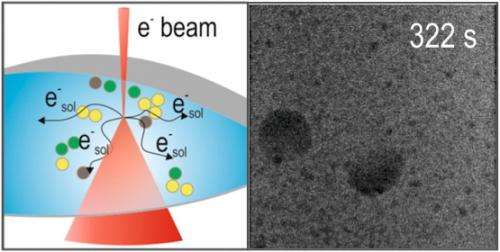Degradation mechanisms uncovered in li-ion battery electrolytes

(Phys.org) —A team led by Pacific Northwest National Laboratory has uncovered information about high-demand batteries that could improve an essential component impacting their performance and longevity. The scientists characterized the stability and interconnected degradation mechanisms in electrolytes commonly used for lithium-ion, or Li-ion, batteries. They obtained detailed chemical imaging data using an environmental liquid stage in a scanning transmission electron microscope (STEM).
To develop new battery technologies, novel electrolytes with increased electrochemical stability are needed, preferably solid electrolytes such as inorganic or salt complexes. Finding these electrolytes requires non-invasive tools that can be used in situ at the active particle size level-the nanoscale-to observe the processes that occur during battery operation. In this study, the researchers used STEM.
"Currently, STEM is the only experimental technique that gives information at the nanoscale during the operation of lithium-ion batteries," said Dr. Nigel Browning, Chief Science Officer for PNNL's Chemical Imaging Initiative. "The in situ liquid stage in a STEM allows the reactions inside a battery to be characterized in real time. This study is a proof of principle of the STEM approach that avoids the standard post-mortem analysis of lithium electrolyte breakdown products."
The detailed characterization offered by liquid-stage STEM can provide unique insights into electrolyte behavior, either for use in future in situ battery studies or to test new electrolytes, winnowing the library of candidate solutions for further characterization and reducing the experimental time spent on less effective electrolytes.
In their study, the scientists explored the stability of five different electrolytes commonly used for Li-ion and LiO2 battery applications: three that contained lithium hexafluoroarsenate salt, one containing lithium hexafluorophosphate, and one containing lithium triflate.
The researchers placed miniature environmental chambers with different electrolytes in the path of the STEM's electron beam. By allowing the electrolytes to be examined in a liquid state, even when inserted into the high vacuum of the microscope, these chambers simulated what is found inside an actual battery. Then, the electron beam caused a localized electrochemical reaction inside the liquid cell that sped up electrolyte degradation-the breakdown of a range of inorganic/salt complexes. The microscope acquired real-time images with nanoscale resolution, showing the earliest stages of damage nucleation.
The scientists also used electron energy loss spectroscopy to verify the presence of the electrolyte and measure other experimental parameters.
"Each electrolyte behaved differently in the analysis," said Dr. Patricia Abellan, a PNNL postdoctoral fellow and materials scientist. "The stability of the electrolytes investigated here correlates with electrochemical trends reported in the literature, which suggests that this technique could potentially give new insights into the reduction and degradation processes that take place during the operation of lithium-ion batteries."
Once the effect of the imaging electrons is fully calibrated, this approach could potentially provide insights into the degradation mechanisms that occur during the first stages of solid electrolyte interphase, or SEI, formation, which electrically insulates the electrolyte and prevents further deterioration.
"One day in the near future, in situ STEM could be used to study different processes through direct visualization and in real time," Abellan said. "We could use it to optimize current state-of-the-art and next-generation electrolytes."
More information: Abellan P, BL Mehdi, LR Parent, M Gu, C Park, W Xu, Y Zhang, I Arslan, J Zhang, CM Wang, JE Evans, and ND Browning. 2014. "Probing the Degradation Mechanisms in Electrolyte Solutions for Li-ion Batteries by In Situ Transmission Electron Microscopy." Nano Letters 14(3):1293-1299. DOI: 10.1021/nl404271k.
Journal information: Nano Letters
Provided by Pacific Northwest National Laboratory




















